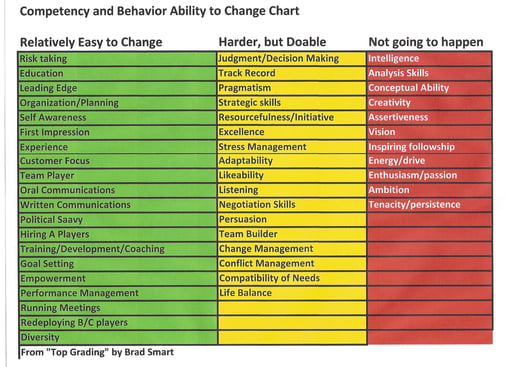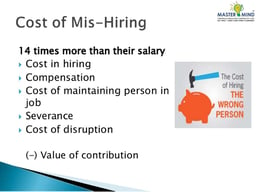This past Wednesday I had the privilege to share the Topgrading Process for a group of business leaders in an Executive Forum meeting in West Des Moines.
One of the participants asked a question about the interview process. “Why doesn’t Topgrading ask questions that probe for the person’s attitude?” You may have read Kids Say the Darndest Things – Formula for Human Potential on how attitude is so critical to achieving our unrealized futures. We agree with this person’s concern for assessing candidate’s attitude.
It’s an insightful question.
When she asked this I reflected on the process and then asked the audience, “What’s the single biggest predictor for future performance?”
Someone answered quickly, “Past Performance!”
Topgrading invests up to three hours with the final candidates for any position by reviewing their most recent positions to determine their performance levels. Did they perform in the top 10% of what you would expect for their position? Are the “A” player potential performers?
For each job in the past 15 years (Approximately 2 hours 40 minutes):
- What were they hired to do?
- Accomplishments?
- Low points.
- People (Topgrading and TORC – discover Boss’s rating and their rating on their bosses).
- Why did they leave?
If you reviewed the Formula for Human Potential you’ll appreciate someone possessing a good attitude naturally would achieve success in their career opportunities.
Topgrading asks many questions to verify the candidate’s demonstrating their attitude. Questions repeatedly drill into their performance, asking specific questions related to results in each of their jobs in the past 15 years. If performance is a result of a good attitude, then their performance should reflect their good attitude.
ATTITUDE COMPETENCY
What I failed to offer to the person asking the question is Topgrading specifically addresses ATTITUDE in the Competencies Interviews immediately preceding the CIDS Interview (Chronological, In-depth, Structured).
Topgrading suggests the following formula for Competency Interviews:
Four 1-Hour Competency Interviews
- Select 4 competencies or more for each interview from your job summary scorecard
- Assign each of you 4 interviewers these 4 or more competencies to interview for during their one hour with the candidate.
- Interviewers choose questions to ask from Competency Questions directed to their specific competencies from the Topgrading Interview Guide
- Conduct 1-hour interviews, allowing 15 minutes for interviewee to ask questions
Prior to your competency interviews you would have selected 12 to 20 competencies for the position you are hiring for, including them in your Job Summary Scorecard.  As you can see from the picture some Competencies are harder to change than others. If any of these competencies (and most assuredly several will be) are in your Job Summary Scorecard for this position you will want to make sure to address these. If your candidates don’t possess these critical competencies for the position it’s doubtful you would want to hire them for the position.
As you can see from the picture some Competencies are harder to change than others. If any of these competencies (and most assuredly several will be) are in your Job Summary Scorecard for this position you will want to make sure to address these. If your candidates don’t possess these critical competencies for the position it’s doubtful you would want to hire them for the position.
There are several competencies that might address the attitude issue but none more important than Enthusiasm/Passion. Topgrading’s definition for Enthusiasm/Passion is: Exhibits dynamism, excitement, and a positive can do attitude.
Enthusiasm/Passion is one of the competencies listed under the column NOT GOING TO HAPPEN. In other words this competency if it’s not present already is not going to suddenly or even eventually show up in a candidate. IF it’s not there already move on if this is a critical competency for this position.
In regard to any competency and what can or cannot be achieved, this comes from an article by Topgrading notes; People who, in job after job, overcome weaker points are usually high potential people with accurate self-awareness, self-objectivity, and a high level of ambition and energy. They show a pattern of soliciting feedback, welcoming coaching, and actually turning weaker points into strong points. Aah - these are the A players you want, the high performers who will welcome your coaching and actually improve!
Another aspect to this question occurs naturally, given the time invested in interviewing a candidate; you will discover the natural disposition of the candidate. No one can successfully hide who they are over 4-8 hours of rigorous interviewing. That’s precisely why you invest the time to discover who they are.
COST OF MISHIRE
 At the presentation Wednesday one of the attendees is a CEO of a ESOP company. When we did the Cost of a Mishire Exercise (which you can do online at Cost of Mis-Hire Calculator) he offered after doing this exercise that it had cost his company close to $1.250 M to “free up their future” employee who had worked for the company for several years. Getting rid of an employee in an ESOP is particularly expensive due to their vested interest in the company.
At the presentation Wednesday one of the attendees is a CEO of a ESOP company. When we did the Cost of a Mishire Exercise (which you can do online at Cost of Mis-Hire Calculator) he offered after doing this exercise that it had cost his company close to $1.250 M to “free up their future” employee who had worked for the company for several years. Getting rid of an employee in an ESOP is particularly expensive due to their vested interest in the company.
What does it cost your company when you hire incorrectly?
People wince when they hear Topgrading recommends interviewing final candidates for a position for up to 3.5 hours. Yet when you calculate the cost of hiring the wrong person it’s a relatively minor inconvenience to get it right the first time. Remember Scrum’s findings on the cost of mistakes? It would be a good time to go back and read this blog Fix Now or Later? The blog shares how PALM the original PDA discovered it took 24x longer to fix a problem later versus fixing it immediately.
This blog also shares how the German auto makers spent more time fixing a car they’d just made than the Japanese did making one in the first place.
Evaluating your team on a regular basis to determine the number of “A” players you have is a best practice we coach our Gazelles customers to perform at least semi-annually. We went through this exercise as well at the presentation Wednesday. Sometimes an employee who exhibits the company’s Core Values isn’t performing in their present position. Sometimes reassigning them can be exactly the right move to keep a good employee who just needs to find a better fit for their talent.
Reading “Rebel Yell,” the biography of Stonewall Jackson, presents a very insightful story on reassigning. We’ll explore this in our next blog.






.jpeg?width=150&height=135&name=Hand%20with%20marker%20writing%20the%20question%20Whats%20Next_%20(1).jpeg)

